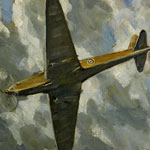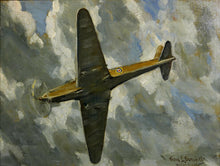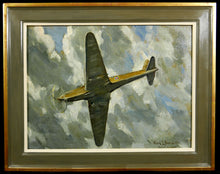‘A Fairey Battle, Binbrook’ - Frank Ernest Beresford, 1940
Adding product to your cart
Overall: 39.5cm (15.5in) x 49cm (19.5in)
Oil on board, signed and ‘Frank E. Beresford / Binbrook 1940’ lower right. Titled verso ‘‘A Fairey Battle, Binbrook’. Board: 30cm (12in) x 40cm (15.75in). Framed.
The title of the present work reveals Beresford’s Fairey Battle belonged to 142 Squadron which arrived at R.A.F. Binbrook, Lincolnshire on 3 July 1940 having sustained heavy losses in the Battle of France as part of the Advanced Air Striking Force. Powered with the same Rolls-Royce Merlin engine as the Spitfire and Hurricane, the Battle was disadvantaged by the weight of a three man crew and a bomb load that made it easy prey for Luftwaffe fighters and anti-aircraft fire. In answer to the Blitzkreig in the west in May 1940 the Battles of A.A.S.F. were called upon to perform unescorted low-level attacks against the German advance. In the first of two sorties carried out by Battles on 10 May 1940, thirteen out of 32 aircraft were lost. Next day in a another R.A.F. sortie against a German column, only one Battle out of eight survived. Losses in excess of 50 percent of Battles per mission were not infrequent. On 12 May a formation of five Battles from 12 Squadron tried to halt the German advance by attacking two road bridges over the Albert Canal. Four of the five Battles were destroyed while the final aircraft crash-landed upon its return to its base. Two Victoria Crosses were awarded posthumously for the action. Following 142 Squadron’s withdrawal to the England, it received more Battles in spite of their glaringly obvious obsolescence and flew sorties against German invasion barges being assembled on the French coast. In November 1940 the squadron received the first of its replacement Vickers Wellington heavy bombers and left Binbrook for R.A.F. Waltham on the 26th. By the end of 1940 the Battle had been withdrawn from front-line squadrons and relegated to training units overseas.
Frank Ernest Beresford (1881-1967) served as an instructor in the Home Guard and as an official War Artist for the R.A.F. He was also accredited to the United States Army and United States Army Air Force. For three years he painted and sketched on air stations across Britain (often rising at dawn to paint military aircraft) including depictions of R.A.F., U.S.A.A.F., Dutch and Polish air crews. At the end of the war, he received an Exceptional Service Award from the U.S.A.A.F. His many wartime commissions included a portrait of the Spitfire designer R.J. Mitchell; ‘Demolition of the Blitzed House of Commons’ (1945), being a powerful rendering of the remains of the House of Commons Chamber destroyed by enemy action on 10-11 May 1941; and ‘Deep Effort to Regensburg’ (1943), a depiction of US B-17 bombers flying over the Alps.
Beresford had a long artistic education. He first studied at the Derby School of Art, then St John's Wood Art School, and finally at the Royal Academy Schools. Between 1906 and 1908, Beresford was elected to a British Institution Scholarship and embarked on a 30,000 mile, 18-month-long international painting tour, during which he attended the Meiji Emperor’s annual tea party in Tokyo. Before the Great War, Beresford also designed murals for St Bartholomew the Great Church, Smithfield and received an art award from the Japanese Government (1909). During the First World War Beresford enlisted the London Regiment and served as an instructor, rising to the rank of Sergeant Major. A regular exhibitor at the Royal Academy, he was an early member of the United Society of Artists (founded 1921) and of the New Society of Artists. Operating from his studio in St John’s Wood, he made a comfortable living as a portrait painter of the great and the good. In 1936, he executed his best known painting - the lying in state of George V with the Princes keeping vigil overnight. It was bought by Queen Mary who gave it to King Edward VIII on his birthday.






